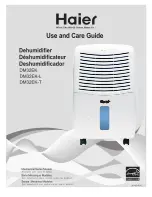
9
CTK 190 mobile air dehumidifier
•
Repairs to closed components
Before repairing closed
components/housing parts, the
unit must be free from voltage.
If carrying out the repairs free
from voltage cannot be avoided,
the critical points of potential
refrigerant leakages must be
checked using a leak detector.
The following notes must be
observed when working on
electronic components if the
housing is changed in such a
way that its safety is influenced.
This also relates to cases where
the lines are damaged, there
is excessive or incorrect pin
assignment, connections are
not assigned in the original
way or similar deviations to
the expected condition are
determined.
•
Repairing intrinsically safe
components
Do not introduce permanent
inductive or capacitive loads
into the existing circuits without
ensuring that the maximum
permitted voltages and
amperages of the assemblies
and lines are not exceeded.
Intrinsically safe components are
individual components that can
be operated in the presence of
flammable substances. The test
equipment must be adjusted
according to the situation-
dependent conditions. Only use
components which are officially
approved by the manufacturer
as spare parts. Unapproved
components can cause a fire
in the event of a leakage in the
refrigerant circuit.
•
Wiring
Lines must be checked for the
following damage:
- Damage to the insulation -
Corrosion at the contact points
- Excessive pressure on the lines
- Damage due to vibrations
- Damage due to sharp edges
- Damage due to other
influences not mentioned here
Also consider the ageing of
the material and continuous
vibration loads due to
compressors or fans when
checking.
•
Identify combustible refrigerant
Do not use any potential
ignition source when searching
for refrigerant leaks under any
circumstance. The use of a leak
detection lamp or other similar
units with a naked flame is not
permitted.
1. Ensure that the components
are installed correctly.
2. Ensure that sealing materials
are not changed in such a way
that combustible gases or
objects could penetrate into the
interior of the components.
3. Spare parts must correspond
to the manufacturer’s
specifications.
•
Leak detection methods
The following leak detection
methods are permitted for
systems with combustible
refrigerants. Electronic
equipment must be used
for detecting leaks. These
must be selected with the
sensitivity matched to the
situation and recalibrated if
necessary (calibration must
take place in a refrigerant-free
environment). The leak detection
device must be adjusted to
the lowest flammability limit
(LFL) of the refrigerant. Liquid
leakage instruments are
permitted for most refrigerants.
Chlorinated substances are
the exception here as the
chlorine in combination with
the refrigerants can cause
corrosion on the copper cables.
If a leak is detected, all potential
open ignition sources must be
removed immediately. If a leak
has been detected in the system
which requires reworking of the
piping in the form of soldering,
the system must be completely
free of refrigerant or, if possible,
the affected part disconnected
from the system using stopcocks.
The affected system parts must
be flushed with oxygen-free
nitrogen run before and during
the repair work.
•
Emptying and evacuating the
system
If the refrigerant circuit must
be opened for repairs or other
reasons, this must be carried out
in a safe and professional way. In
any event, proceed with extreme
caution since ignition may occur
at any time!
NOTE!
The use of silicones can influence
the effectiveness of leak
detection devices!
Intrinsically safe components
must not be insulated before
starting work!










































